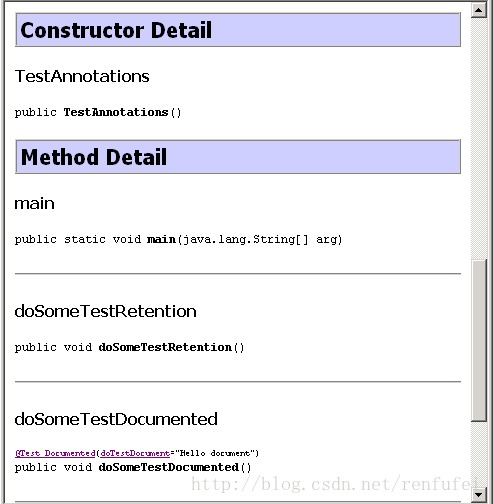Retention注解
Retention(保留)注解说明,这种类型的注解会被保留到那个阶段. 有三个值:
1.RetentionPolicy.SOURCE —— 这种类型的Annotations只在源代码级别保留,编译时就会被忽略
2.RetentionPolicy.CLASS —— 这种类型的Annotations编译时被保留,在class文件中存在,但JVM将会忽略
3.RetentionPolicy.RUNTIME —— 这种类型的Annotations将被JVM保留,所以他们能在运行时被JVM或其他使用反射机制的代码所读取和使用.
示例5演示了 RetentionPolicy.RUNTIME 的声明:
Java注解的示例1:
@Retention(RetentionPolicy.RUNTIME)
public @interface Test_Retention {
String doTestRetention();
}
在这个示例中, @Retention(RetentionPolicy.RUNTIME)注解表明 Test_Retention注解将会由虚拟机保留,以便它可以在运行时通过反射读取.
Documented 注解
Documented 注解表明这个注解应该被 javadoc工具记录. 默认情况下,javadoc是不包括注解的. 但如果声明注解时指定了 @Documented,则它会被 javadoc 之类的工具处理, 所以注解类型信息也会被包括在生成的文档中. 示例6进一步演示了使用 @Documented:
Java注解的示例2:
@Documented
public @interface Test_Documented {
String doTestDocument();
}
接下来,像下面这样修改TestAnnotations类:
public class TestAnnotations {
public static void main(String arg[]) {
new TestAnnotations().doSomeTestRetention();
new TestAnnotations().doSomeTestDocumented();
}
@Test_Retention (doTestRetention="保留注解信息测试")
public void doSomeTestRetention() {
System.out.printf("测试注解类型 'Retention'");
}
@Test_Documented(doTestDocument="Hello document")
public void doSomeTestDocumented() {
System.out.printf("测试注解类型 'Documented'");
}
}
现在,如果你使用 javadoc命令生成 TestAnnotations.html文件,你将看到类似于图1的结果.

从截图可以看到,文档中没有 doSomeTestRetention() 方法的 annotation-type信息()方法. 但是, doSomeTestDocumented() 方法的文档提供了注解的描述信息. 这是因为 @Documented标签被加到了Test_Documented注解上. 之前的注解Test_Retention并没有指定 @Documented 标记(tag).
Inherited 注解(这段可能有问题...)
这是一个稍微复杂的注解类型. 它指明被注解的类会自动继承. 更具体地说,如果定义注解时使用了 @Inherited 标记,然后用定义的注解来标注另一个父类, 父类又有一个子类(subclass),则父类的所有属性将被继承到它的子类中. 在示例7中,你会看到使用 @Inherited 标签的好处.
Java注解的示例3
首先,定义你的注解:
@Inherited
public @interface MyParentObject {
boolean isInherited() default true;
String doSomething() default "Do what?";
}
接下来,使用注解标注了一个类:
@MyParentObject
public Class MyChildObject {
}
正如你看到的,你不需要在实现类中定义接口方法. 因为使用 @Inherited标记,这些都自动继承了. 如果你使用一种古老的方式定义实现类,会是什么样子呢? 看看下面这张 古老的实现方式吧:
public class MyChildObject implements MyParentObject {
public boolean isInherited() {
return false;
}
public String doSomething() {
return "";
}
public boolean equals(Object obj) {
return false;
}
public int hashCode() {
return 0;
}
public String toString() {
return "";
}
public Class annotationType() {
return null;
}
}
看到的区别吗? 可以看到,你必须实现父接口的所有方法. 除了isInherited()和从myParentObject doSomething()方法外,你还需要实现 java.lang.Object的 equals(),toString()和hasCode()方法. 还有 java.lang.annotation.Annotation 类的 annotationType()方法. 不管你是不是想要实现这些方法,你必须在继承的对象中包含这些.